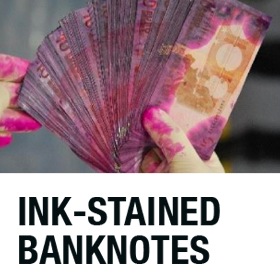Search by product, support information & more
Most popular searches:
Search for "PA00185"Read our Latest Blogs >
Click here for Technical Support >
We’ve got a new look! Please note: all users need to re-register to take advantage of our new website functionality
By Marcus Tiedt, Sales & Marketing Director, ITL
Ink stained banknotes are a result of anti-theft devices, also known as Intelligent Bank Neutralisation Systems (IBNS) which is widely used across Europe. The aim of IBNS systems is to deter crime and to ensure that criminals do not benefit from crime, IBNS is activated in the event of a robbery or theft when criminals open a protected cash container, such as an ATM or a safe when cash is being transported. It stains banknotes in various colours – typically red, purple, pink, blue, black or green, as well as combinations of these colours. These systems make stolen banknotes unusable and worthless, and therefore reduce the risk for retailers, banks and other cash handlers of becoming victims of crime.
In the US, dye packs or radio-controlled incendiary devices are used by banks to permanently dye notes after a robbery. The dye pack is placed in a hollowed-out space within a stack of banknotes which are stored next to the cashier and successfully foil robberies in over 75% of banks in the US (Source: Wikipedia).
National Central Banks remove stained notes from circulation, but retailers and members of the general public should be aware that if they receive a stained banknote, it is almost certainly a stolen banknote, and should not be accepted.
However, not all notes with stains are stolen. If there are very light stains or some small marks and all the edges are intact then the stains or marks are not likely to be a result of any anti-theft device and will most probably be accidental and therefore not stolen.
National Banks set minimum standards to allow banknote handling machines to set thresholds for the amount of ink present in order for the note to be defined as neutralised or rendered useless.
The ink on a banknote produced by IBNS usually soaks into the banknote paper and is generally more evident at the edges. Typically, the ink flows from the edges to the centre of the banknote to make a distinct pattern (Source: Banco de Portugal).
It is important for retailers, operators and indeed any organisation who handle cash that stained banknotes are not accepted either manually or electronically during the validation process because you will not always be entitled to reimbursement from the bank. If you do not have the correct cash handling security technology in place and ink-stained banknotes are accepted, they need to be presented to the National Central Bank who would firstly check if the stain is a result of IBNS.
The European Central Bank (ECB) has adopted replacement rules for damaged or mutilated (e.g. partially burnt, cut, discoloured or decomposed) banknotes. These rules are equally applied by all national central banks of the Eurosystem. They are outlined in a public ECB Decision which defines the criteria to be met if you present a damaged banknote for exchange (Source: European Central Bank).
This Decision contains the rules for the exchange of euro banknotes damaged by anti-theft devices (IBNS). Essentially, banknotes damaged by IBNS can only be exchanged at the request of the original owner, or its appointed agent, who has become victim of the crime (Source: National Bank of Belgium).
Therefore if investigations reveal that the ink stains are from an IBNS, you will not be entitled to a reimbursement because National Central Banks can only exchange euro banknotes stained by anti-theft devices at the request of the original banknote owner who was the victim of the crime that led to the staining of the banknotes. If you have a genuine banknote that has been damaged by anti-theft devices you need to provide a written statement outlining the cause of neutralisation. If the stain is not a result of IBNS you will of course be eligible for reimbursement.
It’s inevitable that not all stained notes will be spotted and removed by National Central Banks, operators, retailers or members of the public. ITL have developed Spectral technology in our cash validation suite of products to ensure that stained notes are detected before they can be redeemed or ‘cleaned’ by criminals. Casinos, banks, kiosks and retailers can all benefit from this technology.
Gaming machines are just one example of where criminals try to launder stained or fraudulent banknotes by depositing dye-stained notes into machines. These machines can therefore pose a threat to the Casino Operator if they do not have the latest technology installed to combat this. Operators need to think about all aspects (products, service, games) which can be used to facilitate money laundering. They also need to consider the way that customers place their bet or gamble on machines and conduct a full risk assessment on depositing of ink stained notes in gaming machines (Source: UK Gambling Commission).
The introduction of Spectral Technology in our validators is an important and unique technological milestone. This technology includes full spectral imaging to validate the authenticity of notes offering exceptional protection against fraudulent and stained notes and best in class performance. State of the art spectral sensors offer complete note image capture (highest spectral coverage) scanning millions of datapoints to authenticate the validity of notes and give the highest level of stained note detection.
Fraudulent, stained notes are a real problem for some countries, so this technology is something that is being requested more and more from our customers. We will therefore be integrating this into many applicable new products in the future.
For more information visit our website Products.
https://www.ecb.europa.eu/euro/banknotes/ink-stained/html/index.en.html
https://www.ecb.europa.eu/ecb/legal/pdf/l_11820130430en00370042.pdf https://www.bancaditalia.it/compiti/emissione-euro/banconote/index.html?com.dotmarketing.htmlpage.language=1 https://www.bportugal.pt/en/page/ink-stained-banknotes
https://www.dnb.nl/en/payments/dnb-en-eurobankbiljetten/beschadigde-biljetten/index.jsp https://www.riksbank.se/en-gb/payments–cash/notes–coins/notes/security-ink-dyed-banknotes/ https://www.mybsn.com.my/content.xhtml?contentId=1057 https://www.resbank.co.za/BanknotesandCoin/SouthAfricanCurrency/BankNotes/Pages/Dye-Stainedbanknotes.aspx
https://www.nbb.be/en/notes-and-coins/damaged-banknotes-and-forgeries/ink-stained-banknotes
https://www.nbb.be/en/notes-and-coins/damaged-banknotes-and-forgeries/ink-stained-banknotes/what-are-current-regulations
https://www.ecb.europa.eu/euro/banknotes/ink-stained/html/index.en.html
https://www.ecb.europa.eu/euro/banknotes/mutilated/html/index.en.html
https://www.association-secure-transactions.eu/industry-information/stained-banknotes/
https://www.ecb.europa.eu/euro/cashprof/cashhand/recycling/html/fitness.en.html
https://www.glory-global.com/en-gb/blogs/en_gb/2017/would-you-accept-this-banknote-as-payment/
https://www.gamblingcommission.gov.uk/for-gambling-businesses/Compliance/General-compliance/AML/The-Prevention-of-Money-Laundering/2-G-Product-risk.aspx
http://www.abb.uk.com/wp-content/uploads/2018/05/GAMLG-BROCHURE.pdf
https://en.wikipedia.org/wiki/Dye_pack
